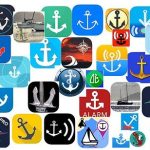
Digital Yacht’s Nomad portable Class B AIS transponder received a DAME Special Mention and as someone who once did numerous yacht deliveries I certainly agree with the judges about its potential usefulness. Moving an unfamiliar boat which may well be brand new and untested — or in that scary gap known as “between owners” — is challenging enough. I remember how incredibly valuable the first handheld GPS receivers were for delivery work, and the Nomad could be the center of an amazing portable nav system.

The Nomad uses USB for both power and data, it has WiFi output as well as a built-in GPS with internal antenna, and its included QMAX 10-inch VHF/AIS antenna attaches with a suction cup. Add a USB power pack (like the versatile beauties from Weego), a tablet, and a charting app that can take in GPS and AIS over WiFi (Pocket Mariner SeaNav shown), and you could step aboard with a completely self-contained navigation system that not only displays AIS-equipped vessels along your route but puts your temporary ride on their AIS screens.
Now there is an obvious problem with moving boat-to-boat with an AIS that’s still basically designed to be used on one vessel with one MMSI number. In fact, even in areas outside the U.S. where an owner can setup their MMSI into a new Class B AIS, they still can’t change it later. But even here in the U.S. you can change the vessel name and dimensions using PC software, and the Nomad’s USB cable certainly supports PC use too.
While I think that the Class B boat switching issue can be managed without causing trouble, or getting into it, a smaller and less expensive alternative for portable navigation is an AIS receiver. You won’t get the benefit of transmitting your boat position, speed, heading, and (temporary) ID, and I don’t know of an AIS receiver with WiFi built in, but DY’s AIS100 has the power/data USB connection, and the similar AMEC Cypho-150S includes an antenna splitter.
Further off the beaten track — plus even smaller, less power hungry and cheaper — is the dAISy 2+ AIS Receiver. Note that the developer is quite frank about the performance limitations of dAISy’s single chip radio, but I’ll add that even the original daisy did fairly well in my testing. I only saw slightly reduced range and sensitivity compared to bigger brand receivers using the same antenna, and the dAISy was easy to setup because there were none of the USB driver issues sometimes encountered with other AIS devices.
Finally, I’ll bet that some clever DIY navigator could built an interesting portable nav system using the dAISy HAT with a Rasberry Pi microcomputer, a combination that also seems good as the basis of an inexpensive self-contained Marine Traffic AIS reporting station. If you tackle either project and succeed, please let us know.



Comments are closed